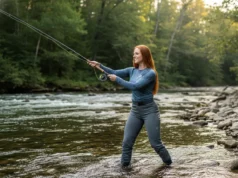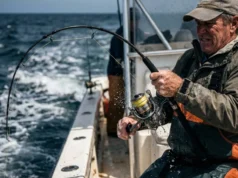In this article
The silence of a frozen lake is broken only by the wind. Below the ice, a trophy walleye gently inhales your jig, a bite so subtle it’s more a change in pressure than a distinct “tap.” Do you feel it? The difference between a story about the one that got away and a photo on your phone often comes down to the ice fishing rod and reel combo in your hands. Choosing the best ice fishing combo isn’t about finding a single “best” option; it’s about matching a finely tuned, balanced and integrated setup to your specific target species, technique, and style, whether you’re chasing perch, crappie, or pike.
This guide is your roadmap from the overwhelming aisles of fishing gear to the quiet confidence of a seasoned angler. We will discover the five critical performance factors for any ice fishing rod and reel combo, starting with sensitivity—the most important attribute on the ice. You will come to understand the key technical specifications—rod power, action, rod length, and rod material—and how they dictate a combo’s ideal use. We will then explore our top-rated combos for 2025, curated for three distinct angler types: The Finesse Panfish Specialist, the All-Around Predator Hunter, and the Budget-Conscious Beginner. By the end, you will walk away with a clear, data-driven framework to select the perfect combo for your needs, ensuring you never miss a light bite again.
How to Choose the Right Ice Fishing Combo: An Expert’s Framework
To make a smart, confident choice, we need to deconstruct what makes an ice fishing combo effective. This section will arm you with the objective knowledge to select a tool that feels less like equipment and more like an extension of your senses for successful hardwater fishing.
Why is Sensitivity the Ultimate Game-Changer in Ice Fishing?
In the frigid water beneath the ice, a fish’s metabolism slows dramatically. This results in bites that are often incredibly light and subtle—sometimes just faint “ticks,” gentle pressure changes, or even “up-bites,” where a fish like a crappie lifts the lure and creates slack in your line. Detecting these whispers is the key to a successful day with finesse presentations.
Sensitivity in an ice fishing rod comes in two primary forms. The first is tactile sensitivity, which is the ability to feel the bite as vibrations travel through the rod blank to your hand. This is where rod materials like solid carbon blanks and 36-ton graphite shine, as their stiffness transmits even the slightest contact for high-end sensitivity. The second form is visual sensitivity, which is the ability to see the bite by watching a built-in strike indicator. So-called “noodle” rods, often made of flexible fiberglass with a soft tip, excel here, as their tips will visibly dip or rise with the lightest touch from bluegill. The direct benefit is undeniable: higher sensitivity leads to an improved hookup percentage and more fish caught. This link connects our discussion of rod sensitivity to the broader context of essential gear needed for a first-time ice angler, reinforcing the combo’s central importance as a core component of your essential ice fishing gear.
While sensitivity helps you detect the bite, you need the right blend of power and durability to finish the fight.
How do Durability and Backbone Prevent Lost Fish?
Ice fishing gear endures some of the harshest conditions imaginable. It faces sub-zero temps, the abrasive edges of drilled ice holes, and the constant stress of being transported in sleds and buckets. Durability is a combo’s fundamental ability to withstand this abuse without failing. Materials like resilient fiberglass and advanced composites are often used to build rods with a solid blank that can take a beating and keep performing season after season.
Beyond simple toughness, a rod needs “backbone.” This isn’t about the sensitive tip; it’s the strength and power stored in the lower two-thirds of the rod blank. This good backbone is absolutely critical for two things. First, it provides the hook-setting power needed to drive a hook into the hard, bony mouth of a fish like a walleye. Second, it gives you the leverage to control and steer a large fish like a pike or lake trout, preventing it from running into the sharp, line-slicing edge of the ice hole.
The rod provides the power, but the reel must perform flawlessly under pressure to manage the line and the fish.
What Makes a Reel Perform in Extreme Cold?
An ice reel has two primary functions: hassle-free line management and fighting the fish with a smooth drag system. In the extreme cold, both are put to the test. A quality drag system is paramount; it must release line consistently without sticking or stuttering, a common failure point that leads to snapped light lines and lost fish. Quality ice reels achieve this smoothness by using special cold gear lube that resists freezing and thickening, ensuring consistent performance from the reel bearings. Your choice of line is also crucial; light 2lb monofilament offers forgiveness and stretch for panfish, while 4-6lb fluorocarbon or braid with a fluoro leader provides the strength and low-stretch sensitivity needed for walleye jigging.
Pro-Tip: Before your first trip of the season, pull a few feet of line off your reel and check the drag. If it feels sticky or inconsistent, turn the drag all the way off and let the reel warm up to room temperature. This often helps redistribute the lubricant and can restore its smooth function.
When it comes to reel types, anglers generally choose between two styles. Versatile spinning reels with a proper reel size—like a 500 series for panfish or a 750 series for predators—are the familiar workhorses that can handle almost any situation. For anglers focused on vertical jigging, however, purpose-built inline reels offer a significant advantage by completely eliminating the line twists that spinning reels can impart on a lure, resulting in a more natural presentation. A great rod and reel are only effective if they feel like a cohesive unit in your hand, and a key part of that is properly setting your fishing drag to match your line and target species.
| Reel Decision: Spinning vs. Inline | ||
|---|---|---|
| Feature | Spinning Reel | Inline Reel |
| Line Twist | Can impart twists on the line, affecting lure presentation. | Eliminates line twist, allowing for a more natural lure presentation. |
| Best Use Case | Versatile all-around option suitable for most ice fishing situations. | Specialized for vertical jigging and finesse presentations. |
| Ease of Use | Familiar to most anglers, making it easy to pick up and use. | May require a slight learning curve but excels in its specific application. |
Our Selection Process: How We Built This Guide
To build absolute trust, we want to be transparent about our rigorous research and curation process. Our commitment to objectivity is paramount. The recommendations you see here are not based on brand loyalty, but on a systematic evaluation of performance, specifications, and real-world user feedback. Our goal is to empower you to make the best choice for your specific needs.
We developed an evaluation framework to judge every product against the five critical performance attributes we’ve established in this guide: Sensitivity, Durability/Backbone, Reel Performance, Balance/Ergonomics, and Versatility for Species. We then conducted a comprehensive market analysis of new and flagship models for the 2025 season. This list was filtered by identifying the top performers for the three most common ice angler personas, ensuring our picks align with distinct fishing styles and priorities. Finally, a note on affiliate links: if you purchase a product through a link on our site, we may earn a small commission at no extra cost to you. This helps support our work, but our recommendations are always driven by performance and value first.
The Best Ice Fishing Combos of 2025: Our Top Recommendations for Every Need
Here we present our curated top recommendations for the key user personas. Each combo has been selected to excel for a specific style of angling, matching the right features to the right fish.
Our Top Picks for the Finesse Panfish Specialist
This angler is a technician who values bite detection above all else for targeting crappie, bluegill, and perch. Their gear must transmit the faintest bites, whether through feel or sight. The following products are elite tools for this demanding style of fishing, perfect for working smaller finesse baits with tungsten jigs and detecting the lightest bites.
Our Top Picks for the All-Around Predator Hunter
This angler is motivated by the thrill of the hunt for larger species like walleye, pike, and lake trout. They need powerful, durable, and versatile gear that can handle heavier setups with larger baits and control strong fish. These are workhorse combos built for battle and big-game pursuits.
Our Top Picks for the Budget-Conscious Beginner
This angler is new to the sport or a casual participant. Their primary concerns are overall gear value, durability, and ease of use. They need a forgiving, versatile “jack-of-all-trades” combo that won’t break the bank. This entry-level advice focuses on the best starting points that represent a great “go to combo” for anyone’s first ice fishing purchase, especially when comparing beginner vs. advanced setups.
Pro-Tip: Many budget-friendly combos come with a basic reel. If you find the rod is perfect but the reel feels lacking after a season, don’t be afraid to upgrade just the reel. A smoother reel with a better drag can transform a good combo into a great one for a minimal investment.
Conclusion
The path to hardwater confidence begins with understanding your gear. The single most important attribute of an ice fishing combo is sensitivity, allowing you to detect subtle bites in cold water. A strong backbone is essential for setting the hook and controlling larger fish, while a smooth drag protects light line from breaking. The rod material is the foundation of performance: carbon excels at tactile sensitivity, while fiberglass is ideal for visual sensitivity and durability. The best choice is always a combo matched to your target species and technique, whether you’re a panfish specialist, a predator hunter, or a beginner. As part of sustainable angling, using a sensitive setup also aids in catch-and-release techniques, allowing for quick releases that ensure the health of the fishery.
Armed with this knowledge, review the picks for your angler type and select the combo that will transform your time on the ice. Share your experiences and questions in the comments below—we’re all here to learn and catch more fish.
Frequently Asked Questions about Ice Fishing Combos
What is the best all-around ice fishing combo for a beginner?
A beginner should look for a durable, versatile combo with a Medium or Medium-Light power and a Fast action, typically made from a fiberglass or composite blank. The Shakespeare Ugly Stik GX2 Ice Combo is our top recommendation as it excels in durability and versatility, making it perfect for learning on a variety of species.
Do I really need an inline reel for ice fishing?
No, you don’t need an inline reel, but it offers a significant advantage for vertical jigging with small lures by eliminating the line twists that standard spinning reels can cause. If you are a serious panfish angler, an inline reel like the one on the 13 Fishing FreeFall Ghost Maverick Combo can lead to a more natural presentation and more bites.
What’s the difference between rod power and rod action?
Rod power describes the amount of force needed to bend the rod (its lifting strength), while rod action describes where the rod bends along its blank. For example, a Medium power rod has the strength for walleye, and a Fast action means it bends primarily in the top third, making it sensitive and quick on the hookset.
Is an expensive ice fishing combo worth the money?
It depends on your priorities; expensive combos offer superior sensitivity, lighter weight, and smoother reels, which can translate to detecting more bites and a more enjoyable experience for a dedicated angler. For a casual angler, a budget-friendly option like the 13 Fishing Thermo Ice Combo provides excellent performance and value for the price.
Risk Disclaimer: Fishing, boating, and all related outdoor activities involve inherent risks that can lead to injury. The information provided on Master Fishing Mag is for educational and informational purposes only. While we strive for accuracy, the information, techniques, and advice on gear and safety are not a substitute for your own best judgment, local knowledge, and adherence to official regulations. Fishing regulations, including seasons, size limits, and species restrictions, change frequently and vary by location. Always consult the latest official regulations from your local fish and wildlife agency before heading out. Proper handling of hooks, knives, and other sharp equipment is essential for safety. Furthermore, be aware of local fish consumption advisories. By using this website, you agree that you are solely responsible for your own safety and for complying with all applicable laws. Any reliance you place on our content is strictly at your own risk. Master Fishing Mag and its authors will not be held liable for any injury, damage, or loss sustained in connection with the use of the information herein.
Affiliate Disclosure: We are a participant in the Amazon Services LLC Associates Program, an affiliate advertising program designed to provide a means for us to earn advertising fees by advertising and linking to Amazon.com. As an Amazon Associate, we earn from qualifying purchases. We also participate in other affiliate programs and may receive a commission on products purchased through our links, at no extra cost to you. Additional terms are found in the terms of service.





